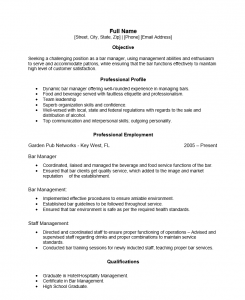
|
Bartender Manager Resume Template |
The Bartender Manager Resume Template can be used as an effective tool in the search for a bartender manager position. This document template will provide the necessary sections that every employer will want see when ascertaining whether they have a viable candidate for an in-person interview. Bartender Managers are an integral part of any establishment’s work force. They are the go-to people when there is an issue and are responsible for developing and maintaining an ongoing system of operation. Those who apply for this position must be able to show they are prepared for virtually any contingency, are well abreast of such things as mixology and current liquor laws, and possess a strong personality that will enable them to run the bar effectively and profitably. These are just a few examples of what a Bartender Manager Resume needs to showcase as each establishment will have its own nuances and thus its own criteria in addition to the basics.
The Bartender Manager Resume Template automatically eliminates the need to wrestle with formatting decisions and technical issues while eliminating simple errors that may occur if one hurriedly attempts to get a resume out to a potential employer within a short amount of time. So long as a user fills out the contents of each section showing a reasonably high quality of language skills, they may revise the Bartender Manager Resume Template relatively quickly to cater to an individual employer’s needs while increasing his or her chances of attaining an interview as a result of their inquiry.
How to Write
Step 1. The first pieces of information are the most important: Name and Contact Information. It would be a wise idea to enlarge then name slightly. The contact information should go directly below this, be up to date, and accurate.
Step 2. The next step will be to write a brief summary of your professional identity. This may be placed under the heading “Professional Profile.” This section should be one to four sentences.
Step 3. The “Objective” section is where the intention of the resume is declared. It should state why the candidate is sending the resume. It should also demonstrate the benefits of hiring the candidate by way of illustrating how he or she will function in the position. These should be brief statements as opposed to full sentences.
Step 4. The “Professional Employment” section showcases the heart of most resumes: the employment history of the candidate. Each entry will be composed of a previous employer’s name, location, the date range the applicant worked for them, and a description of job duties. They should be listed in reverse chronological order.
Step 5. The final section, Qualifications, may also be titled Education as it will list any training, diplomas, degrees, and/or certificates you earned.


